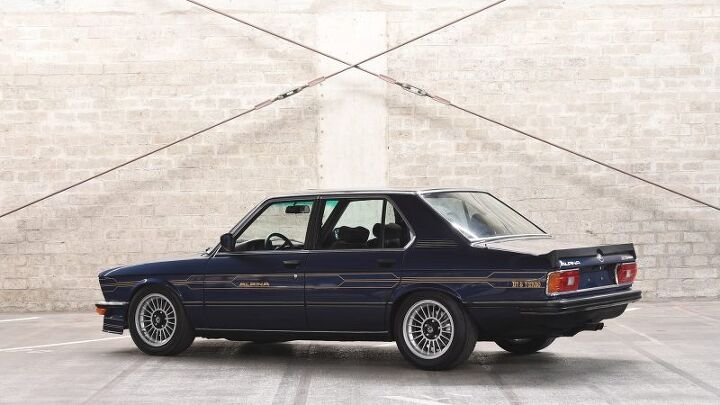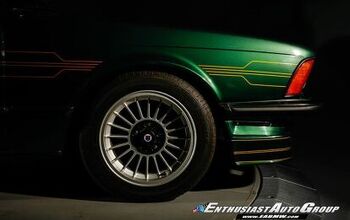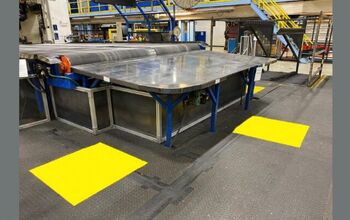Rare Rides: An Incredibly Rare 1982 Alpina B7 S Turbo Sedan

Rare Rides has featured exactly two Alpinas in the past, both coupes. From the Eighties came the B7S Turbo Coupe, a 6 Series-based sporty two-door. The Nineties were represented by the hefty B12, an 8 Series modification which was very expensive.
Today we step back to the Eighties and have a look at a B7S Turbo with twice as many doors.
The E12 5 Series entered production in 1972, as successor to the New Class. As the genesis of the 5 Series, it was also the start of what most consider modern BMW styling: quad headlamps, kidney grille, Hoffmeister kink, and generally boxy styling — everyone accounted for. Not big on large engines in those days, all 5 Series of this generation were endowed with inline-four engines of up to two liters of displacement, or inline-six power ranging from 2.0 to 3.5 liters.
By the time Alpina got around to tinkering with the E12, it was in the latter portion of its life: the first B7 Turbo sedan debuted in 1978. Based on a 528i, Alpina modified the engine and added twin turbos. That upped power output of the 2.8-liter I6 from 173 to a whopping 295 horses. What Alpina created in Malaisey 1978 was the fastest four-door sedan in the world. The B7 Turbo remained in production through the rest of the E12’s run, but Alpina wasn’t finished with its idea.
In 1981, a new version of the B7 arrived with an S added to its moniker. It featured the usual Alpina paint striping, spoilers, and festive upholstery. However, it wasn’t simply a minor modification or trim package on the standard B7. The B7S was based on the new and fastest 5 Series, the 535i. That meant a swap to the largest 3.5-liter inline-six. Alpina turned up the boost on the turbos and created a new ignition system.
Horsepower increased with the larger power plant, to 326. The engine’s torque also improved, jumping from 341 lb-ft on the original B7 to 369 lb-ft on the S. For comparison, the first M5 in 1984 produced 256 horsepower. The second generation M5 for 1988 nearly caught the B7S, with 311 horsepower, but lagged at 266 lb-ft of torque.
The incredibly powerful B7S was at least a decade ahead of its time as far as performance sedans were concerned. Never a big volume producer, Alpina built only 60 examples of its super sedan. All were confined to 1981 and 1982, which was the E12’s final model year. Unlike some rare classics, this particular Alpina has been enjoyed. It’s racked up nearly 137,000 miles in its life, and has been maintained and refreshed along the way. It was auctioned last year in Paris, and was expected to bring between $160,000 and $217,000.
[Images: RM Sotheby’s]

Interested in lots of cars and their various historical contexts. Started writing articles for TTAC in late 2016, when my first posts were QOTDs. From there I started a few new series like Rare Rides, Buy/Drive/Burn, Abandoned History, and most recently Rare Rides Icons. Operating from a home base in Cincinnati, Ohio, a relative auto journalist dead zone. Many of my articles are prompted by something I'll see on social media that sparks my interest and causes me to research. Finding articles and information from the early days of the internet and beyond that covers the little details lost to time: trim packages, color and wheel choices, interior fabrics. Beyond those, I'm fascinated by automotive industry experiments, both failures and successes. Lately I've taken an interest in AI, and generating "what if" type images for car models long dead. Reincarnating a modern Toyota Paseo, Lincoln Mark IX, or Isuzu Trooper through a text prompt is fun. Fun to post them on Twitter too, and watch people overreact. To that end, the social media I use most is Twitter, @CoreyLewis86. I also contribute pieces for Forbes Wheels and Forbes Home.
More by Corey Lewis
Latest Car Reviews
Read moreLatest Product Reviews
Read moreRecent Comments
- Tassos Obsolete relic is NOT a used car.It might have attracted some buyers in ITS DAY, 1985, 40 years ago, but NOT today, unless you are a damned fool.
- Stan Reither Jr. Part throttle efficiency was mentioned earlier in a postThis type of reciprocating engine opens the door to achieve(slightly) variable stroke which would provide variable mechanical compression ratio adjustments for high vacuum (light load) or boost(power) conditions IMO
- Joe65688619 Keep in mind some of these suppliers are not just supplying parts, but assembled components (easy example is transmissions). But there are far more, and the more they are electronically connected and integrated with rest of the platform the more complex to design, engineer, and manufacture. Most contract manufacturers don't make a lot of money in the design and engineering space because their customers to that. Commodity components can be sourced anywhere, but there are only a handful of contract manufacturers (usually diversified companies that build all kinds of stuff for other brands) can engineer and build the more complex components, especially with electronics. Every single new car I've purchased in the last few years has had some sort of electronic component issue: Infinti (battery drain caused by software bug and poorly grounded wires), Acura (radio hiss, pops, burps, dash and infotainment screens occasionally throw errors and the ignition must be killed to reboot them, voice nav, whether using the car's system or CarPlay can't seem to make up its mind as to which speakers to use and how loud, even using the same app on the same trip - I almost jumped in my seat once), GMC drivetrain EMF causing a whine in the speakers that even when "off" that phased with engine RPM), Nissan (didn't have issues until 120K miles, but occassionally blew fuses for interior components - likely not a manufacturing defect other than a short developed somewhere, but on a high-mileage car that was mechanically sound was too expensive to fix (a lot of trial and error and tracing connections = labor costs). What I suspect will happen is that only the largest commodity suppliers that can really leverage their supply chain will remain, and for the more complex components (think bumper assemblies or the electronics for them supporting all kinds of sensors) will likley consolidate to a handful of manufacturers who may eventually specialize in what they produce. This is part of the reason why seemingly minor crashes cost so much - an auto brand does nst have the parts on hand to replace an integrated sensor , nor the expertice as they never built them, but bought them). And their suppliers, in attempt to cut costs, build them in way that is cheap to manufacture (not necessarily poorly bulit) but difficult to replace without swapping entire assemblies or units).I've love to see an article on repair costs and how those are impacting insurance rates. You almost need gap insurance now because of how quickly cars depreciate yet remain expensive to fix (orders more to originally build, in some cases). No way I would buy a CyberTruck - don't want one, but if I did, this would stop me. And it's not just EVs.
- Joe65688619 I agree there should be more sedans, but recognize the trend. There's still a market for performance oriented-drivers. IMHO a low budget sedan will always be outsold by a low budget SUV. But a sports sedan, or a well executed mid-level sedan (the Accord and Camry) work. Smaller market for large sedans except I think for an older population. What I'm hoping to see is some consolidation across brands - the TLX for example is not selling well, but if it was offered only in the up-level configurations it would not be competing with it's Honda sibling. I know that makes the market smaller and niche, but that was the original purpose of the "luxury" brands - badge-engineering an existing platform at a relatively lower cost than a different car and sell it with a higher margin for buyers willing and able to pay for them. Also creates some "brand cachet." But smart buyers know that simple badging and slightly better interiors are usually not worth the cost. Put the innovative tech in the higher-end brands first, differentiate they drivetrain so it's "better" (the RDX sells well for Acura, same motor and tranmission, added turbo which makes a notable difference compared to the CRV). The sedan in many Western European countries is the "family car" as opposed to micro and compact crossovers (which still sell big, but can usually seat no more than a compact sedan).
- Jonathan IMO the hatchback sedans like the Audi A5 Sportback, the Kia Stinger, and the already gone Buick Sportback are the answer to SUVs. The A5 and the AWD version of the Stinger being the better overall option IMO. I drive the A5, and love the depth and size of the trunk space as well as the low lift over. I've yet to find anything I need to carry that I can't, although I admit I don't carry things like drywall, building materials, etc. However, add in the fun to drive handling characteristics, there's almost no SUV that compares.








































Comments
Join the conversation
Stupid price, but it's awesome. And seriously, guys...two comments on this ridiculously cool car? Really?
OMG my dad has this car but it’s a different color! He drives it around all the time!